Composition, Structure and Properties of Geopolymer Concrete Dispersedly Reinforced with Sisal Fiber
Abstract
:1. Introduction
- -
- The development of compositions of geopolymer composites considering the actual properties of raw materials;
- -
- The manufacturing of experimental compositions of geopolymer mortar mixtures using alkaline activators of various concentrations, the selection of the most effective alkaline activator, and the production of geopolymer concretes with various dosages of sisal fiber;
- -
- To conduct experimental studies, which include assessing the fresh properties of geopolymer concrete mixtures, as well as the density, compressive strength, bending strength, and water absorption of hardened composites;
- -
- An analysis of the results and identification of the optimal solutions for the production of geopolymer concrete dispersedly reinforced with sisal fiber.
2. Materials and Methods
2.1. Materials
2.2. Methods
3. Results and Discussion
- -
- The best composition of the alkaline activator is a mixture of sodium liquid glass and sodium hydroxide solution with a molarity of 12M;
- -
- SF in the considered dosages up to 1.6% has a positive effect on the properties of the geopolymer composite;
- -
- The introduction of SF into the geopolymer concrete mixture does not have a significant effect on the change in its density. However, dispersed reinforcement with sisal fiber reduces the settlement of the geopolymer concrete mixture. This dependence is direct and decreases with increasing sediment fiber content. At the maximum SF content of 1.6% considered in this study, the reduction in the mixture slump was 67.2%;
- -
- The dispersed reinforcement of the SF geopolymer concrete improves its physical and mechanical properties. The greatest positive effect was recorded at an SF content of 1.0%. The increase in the compressive strength was 12.8%, the flexural strength increased by 76.5%, and water absorption decreased by 10.3%. With a dosage of sisal fiber of about 1%, the maximum increases in the compressive strength and flexural strength of the geopolymer concrete were obtained, as well as the maximum reductions in the water absorption of the geopolymer concrete in comparison with the composite without sisal fiber. The structure of the geopolymer concrete with this dosage of sisal fiber had the highest visual homogeneity, coherence, and integrity in comparison with the control samples, which confirmed the dependence of the physical and mechanical characteristics of the geopolymer concrete on the dosage of sisal fiber.
4. Conclusions
Author Contributions
Funding
Data Availability Statement
Acknowledgments
Conflicts of Interest
References
- Tolstykh, T.; Gamidullaeva, L.; Shmeleva, N.; Gromov, S.; Ermolenko, A. Megapolis as a Symbiosis of Socio-Economic Ecosystems: The Role of Collaboration. J. Open Innov. Technol. Mark. Complex. 2022, 8, 126. [Google Scholar] [CrossRef]
- Baqa, M.F.; Chen, F.; Lu, L.; Qureshi, S.; Tariq, A.; Wang, S.; Jing, L.; Hamza, S.; Li, Q. Monitoring and Modeling the Patterns and Trends of Urban Growth Using Urban Sprawl Matrix and CA-Markov Model: A Case Study of Karachi, Pakistan. Land 2021, 10, 700. [Google Scholar] [CrossRef]
- Al-Kheetan, M.J.; Byzyka, J.; Ghaffar, S.H. Sustainable Valorisation of Silane-Treated Waste Glass Powder in Concrete Pavement. Sustainability 2021, 13, 4949. [Google Scholar] [CrossRef]
- Runganga, D.; Okonta, F.; Musonda, I. Strength and Durability Properties of High-Volume Fly Ash (HVFA) Binders: A Systematic Review. Civil. Eng. 2024, 5, 435–460. [Google Scholar] [CrossRef]
- Moreno, S.; Rosales, M.; Rosales, J.; Agrela, F.; Díaz-López, J.L. Feasibility of Using New Sustainable Mineral Additions for the Manufacture of Eco-Cements. Materials 2024, 17, 777. [Google Scholar] [CrossRef]
- WMO. Greenhouse Gas. Bulletin: The State of the Greenhouse Gases in the Atmosphere Based on Global Observations through 2018. Weather Clim. Water 2019, 15, 191536. [Google Scholar]
- Khan, K.; Ahmad, W.; Amin, M.N.; Nazar, S. A Scientometric-Analysis-Based Review of the Research Development on Geopolymers. Polymers 2022, 14, 3676. [Google Scholar] [CrossRef] [PubMed]
- Castillo, H.; Collado, H.; Droguett, T.; Vesely, M.; Garrido, P.; Palma, S. State of the art of geopolymers: A review. e-Polymers 2022, 22, 108–124. [Google Scholar] [CrossRef]
- Qin, L.; Yan, J.; Zhou, M.; Liu, H.; Wang, A.; Zhang, W.; Duan, P.; Zhang, Z. Mechanical properties and durability of fiber reinforced geopolymer composites: A review on recent progress. Eng. Rep. 2023, 5, e12708. [Google Scholar] [CrossRef]
- Valente, M.; Sambucci, M.; Sibai, A. Geopolymers vs. Cement Matrix Materials: How Nanofiller Can Help a Sustainability Approach for Smart Construction Applications—A Review. Nanomaterials 2021, 11, 2007. [Google Scholar] [CrossRef]
- Mohamed, O.; Zuaiter, H. Fresh Properties, Strength, and Durability of Fiber-Reinforced Geopolymer and Conventional Concrete: A Review. Polymers 2024, 16, 141. [Google Scholar] [CrossRef] [PubMed]
- Kabirova, A.I.; Ibragimov, R.A.; Genç, B.; Korolev, E.V.; Kiyamov, I.K.; Kiyamova, L.I. Research trends in the mechanoactivation of clay minerals used in obtaining geopolymers. Constr. Mater. Prod. 2023, 6, 3. [Google Scholar] [CrossRef]
- Khater, H.M.; El Nagar, A.M.; Ezzat, M. Processing, characterization and hardening mechanism of one-part geopolymer cement. Mag. Civ. Eng. 2022, 116, 11611. [Google Scholar] [CrossRef]
- Eroshkina, N.A.; Chamurliev, M.Y.; Korovkin, M.O. The Influence of Composition of Geopolymer Binder on the Deformation and Strength Properties of Concrete. Obraz. I Nauka V Sovrem. Mire Innovacii 2019, 4, 181–187. [Google Scholar]
- Beskopylny, A.N.; Stel’makh, S.A.; Shcherban, E.M.; Mailyan, L.R.; Meskhi, B.; Shilov, A.A.; Beskopylny, N.; Chernil’nik, A. Enhanced Performance of Concrete Dispersedly Reinforced with Sisal Fibers. Appl. Sci. 2022, 12, 9102. [Google Scholar] [CrossRef]
- Antypas, I.R. Effect of Glass Fiber Reinforcement on the Mechanical Properties of Polyester Composites. Adv. Eng. Res. 2023, 23, 387–397. [Google Scholar] [CrossRef]
- Morgun, V.N. About Dynamics of Improving the Foam Concrete Technological and Operational Properties upon Disperse Reinforcement with Polypropylene Fibers. Mod. Trends Constr. Urban Territ. Plan. 2023, 2, 69–76. [Google Scholar] [CrossRef]
- Yazyev, S.B.; Chepurnenko, A.S. Buckling of Rectangular Plates under Nonlinear Creep. Adv. Eng. Res. (Rostov-on-Don) 2023, 23, 257–268. [Google Scholar] [CrossRef]
- Sharma, U.; Gupta, N.; Bahrami, A.; Özkılıç, Y.O.; Verma, M.; Berwal, P.; Althaqafi, E.; Khan, M.A.; Islam, S. Behavior of Fibers in Geopolymer Concrete: A Comprehensive Review. Buildings 2024, 14, 136. [Google Scholar] [CrossRef]
- Tsai, S.-L.; Wang, H.-Y.; Lin, K.-T.; Hung, C.-C. A Novel Eco-Friendly Thermal-Insulating High-Performance Geopolymer Concrete Containing Calcium Oxide-Activated Materials from Waste Tires and Waste Polyethylene Terephthalate. Buildings 2024, 14, 1437. [Google Scholar] [CrossRef]
- Zhang, X.; Ling, Y.; Wu, Y.; Lai, H.; Wang, Y.; Chen, Z. Comprehensive Analysis of Mechanical, Economic, and Environmental Characteristics of Hybrid PE/PP Fiber-Reinforced Engineered Geopolymer Composites. Buildings 2024, 14, 1094. [Google Scholar] [CrossRef]
- Zuaiter, M.; El-Hassan, H.; El-Maaddawy, T.; El-Ariss, B. Properties of Slag-Fly Ash Blended Geopolymer Concrete Reinforced with Hybrid Glass Fibers. Buildings 2022, 12, 1114. [Google Scholar] [CrossRef]
- Alomayri, T.; Adesina, A. The influence of nano CaCO3 on the mechanical performance of micro glass-reinforced geopolymer paste. Arab. J. Geosci. 2021, 14, 1369. Available online: https://link.springer.com/article/10.1007/s12517-021-07839-0 (accessed on 5 September 2024). [CrossRef]
- Ahmed Shaikh, F.U.; Patel, A. Flexural Behavior of Hybrid PVA Fiber and AR-Glass Textile Reinforced Geopolymer Composites. Fibers 2018, 6, 2. [Google Scholar] [CrossRef]
- Kumar, Y.N.; Kumar, B.D.; Swami, B.L.P. Mechanical properties of geopolymer concrete reinforced with steel and glass fibers with various mineral admixtures. Mater. Today Proc. 2022, 52, 632–641. [Google Scholar] [CrossRef]
- Ganesh, A.C.; Muthukannan, M. Development of high performance sustainable optimized fiber reinforced geopolymer concrete and prediction of compressive strength. J. Clean. Prod. 2021, 282, 124543. [Google Scholar] [CrossRef]
- Abbas, S.N.; Qureshi, M.I.; Abid, M.M.; Asad Zia, A.; Tariq, M.A.U.R. An Investigation of Mechanical Properties of Fly Ash Based Geopolymer and Glass Fibers Concrete. Sustainability 2022, 14, 10489. [Google Scholar] [CrossRef]
- Waqas, R.M.; Zaman, S.; Alkharisi, M.K.; Butt, F.; Alsuhaibani, E. Influence of Bentonite and Polypropylene Fibers on Geopolymer Concrete. Sustainability 2024, 16, 789. [Google Scholar] [CrossRef]
- Ahıskalı, A.; Ahıskalı, M.; Bayraktar, O.Y.; Kaplan, G.; Assaad, J.J. Mechanical and durability properties of polymer fiber reinforced one-part foam geopolymer concrete: A sustainable strategy for the recycling of waste steel slag aggregate and fly ash. Constr. Build. Mater. 2024, 440, 137492. [Google Scholar] [CrossRef]
- Thakur, G.; Singh, Y.; Singh, R.; Prakash, C.; Saxena, K.K.; Pramanik, A.; Basak, A.; Subramaniam, S. Development of GGBS-Based Geopolymer Concrete Incorporated with Polypropylene Fibers as Sustainable Materials. Sustainability 2022, 14, 10639. [Google Scholar] [CrossRef]
- Aygörmez, Y.; Canpolat, O.; Al-Mashhadani, M.M.; Uysal, M. Elevated temperature, freezing-thawing and wetting-drying effects on polypropylene fiber reinforced metakaolin based geopolymer composites. Constr. Build. Mater. 2020, 235, 117502. [Google Scholar] [CrossRef]
- Zubarev, K.P.; Shcherban’, E.M.; Stel’makh, S.A.; Beskopylny, A.N.; Elshaeva, D.; Chernil’nik, A.; Zakieva, N.I.; Pimenova, E.V.; Shilov, A.A. Structure and Properties Improvement by Recipe Factors of Geopolymer Basalt Fiber Reinforced Concrete for Building Enclosing Structures. Buildings 2024, 14, 743. [Google Scholar] [CrossRef]
- Heweidak, M.; Kafle, B.; Al-Ameri, R. Basalt Fibres’ Length on Fresh and Mechanical Properties of Self-Compacted Ambient-Cured Geopolymer Concrete. J. Compos. Sci. 2022, 6, 292. [Google Scholar] [CrossRef]
- Dollente, I.J.R.; Valerio, D.N.R.; Quiatchon, P.R.J.; Villoria, M.B.D.; Garciano, L.E.O.; Promentilla, M.A.B.; Guades, E.J.; Ongpeng, J.M.C. Enhancing the Mechanical Properties of Historical Masonry Using Fiber-Reinforced Geopolymers. Polymers 2023, 15, 1017. [Google Scholar] [CrossRef] [PubMed]
- Mahmood, A.; Noman, M.T.; Pechočiaková, M.; Amor, N.; Petrů, M.; Abdelkader, M.; Militký, J.; Sozcu, S.; Ul Hassan, S.Z. Geopolymers and Fiber-Reinforced Concrete Composites in Civil Engineering. Polymers 2021, 13, 2099. [Google Scholar] [CrossRef] [PubMed]
- Ziada, M.; Erdem, S.; Tammam, Y.; Kara, S.; González Lezcano, R.A. The Effect of Basalt Fiber on Mechanical, Microstructural, and High-Temperature Properties of Fly Ash-Based and Basalt Powder Waste-Filled Sustainable Geopolymer Mortar. Sustainability 2021, 13, 12610. [Google Scholar] [CrossRef]
- Guo, X.; Xiong, G. Resistance of fiber-reinforced fly ash-steel slag based geopolymer mortar to sulfate attack and drying-wetting cycles. Constr. Build. Mater. 2021, 269, 121326. [Google Scholar] [CrossRef]
- Qu, W.; Niu, B.; Lv, C.; Liu, J. A Review of Sisal Fiber-Reinforced Geopolymers: Preparation, Microstructure, and Mechanical Properties. Molecules 2024, 29, 2401. [Google Scholar] [CrossRef]
- Liu, J.; Lv, C. Durability of Cellulosic-Fiber-Reinforced Geopolymers: A Review. Molecules 2022, 27, 796. [Google Scholar] [CrossRef]
- Tonoli, G.H.D.; Belgacem, M.N.; Siqueira, G.; Bras, J.; Savastano, H.; Rocco Lahr, F.A. Processing and dimensional changes of cement based composites reinforced with surface-treated cellulose fibres. Cem. Concr. Compos. 2013, 37, 68–75. [Google Scholar] [CrossRef]
- Ardanuy, M.; Clarmunt, J.; Filho, R. Evaluation of durability to wet/dry cycling of cement mortar composites reinforced with nanofibrillated cellulose. Brittle Matrix Comp. 2012, 10, 33–41. Available online: http://hdl.handle.net/2117/17326 (accessed on 5 September 2024).
- Wei, J.; Meyer, C. Degradation mechanisms of natural fiber in the matrix of cement composites. Cem. Concr. Res. 2015, 73, 1–16. [Google Scholar] [CrossRef]
- Lv, C.; Liu, J.; Guo, G.; Zhang, Y. The Mechanical Properties of Plant Fiber-Reinforced Geopolymers: A Review. Polymers 2022, 14, 4134. [Google Scholar] [CrossRef] [PubMed]
- Assaedi, H.; Alomayri, T.; Shaikh, F.; Low, I.-M. Influence of Nano Silica Particles on Durability of Flax Fabric Reinforced Geopolymer Composites. Materials 2019, 12, 1459. [Google Scholar] [CrossRef]
- Rahman, A.S.; Shah, C.; Gupta, N. Simultaneous effects of rice husk silica and silicon carbide whiskers on the mechanical properties and morphology of sodium geopolymer. J. Compos. Mater. 2020, 54, 4611–4620. [Google Scholar] [CrossRef]
- Batista Dos Santos, G.Z.; Passos de Oliveira, D.; de Almeida Melo Filho, J.; Marques da Silva, N. Sustainable geopolymer composite reinforced with sisal fiber: Durability to wetting and drying cycles. J. Build. Eng. 2021, 43, 102568. [Google Scholar] [CrossRef]
- Kavipriya, S.; Deepanraj, C.G.; Dinesh, S.; Prakhash, N.; Lingeshwaran, N.; Ramkumar, S. Flexural strength of Lightweight geopolymer concrete using sisal fibres. Mat. Today Proc. 2021, 47, 5503–5507. [Google Scholar] [CrossRef]
- Sanfilippo, C.; Fiore, V.; Calabrese, L.; Megna, B.; Valenza, A. Effect of sodium bicarbonate treatment on the properties of sisal fibers and their geopolymer composites. CSCM 2024, 21, e03536. [Google Scholar] [CrossRef]
- da Silva Alves, L.C.; Dos Reis Ferreira, R.A.; Bellini Machado, L.; de Castro Motta, L.A. Optimization of metakaolin-based geopolymer reinforced with sisal fibers using response surface methology. Ind. Crops Prod. 2019, 139, 111551. [Google Scholar] [CrossRef]
- Wongsa, A.; Kunthawatwong, R.; Naenudon, S.; Sata, V.; Chindaprasirt, P. Natural fiber reinforced high calcium fly ash geopolymer mortar. Constr. Build. Mater. 2020, 241, 118143. [Google Scholar] [CrossRef]
- Özkılıç’, Y.O.; Beskopylny, A.N.; Stel’makh, S.A.; Shcherban’, E.M.; Mailyan, L.R.; Meskhi, B.; Chernil’nik, A.; Ananova, O.; Aksoylu, C.; Madenci, E. Lightweight expanded-clay fiber concrete with improved characteristics reinforced with short natural fibers. CSCM 2023, 19, e02367. [Google Scholar] [CrossRef]
- GOST 30744; Cements. Methods of Testing with Using Polyfraction Standard Sand. State Construction Committee of Russia, GUP CPP: Moscow, Russia, 2001. Available online: https://docs.cntd.ru/document/1200011363 (accessed on 9 August 2024).
- GOST R 57809-2017/EN 12350-2:2009; Testing Fresh Concrete. Part 2. Slump Test. Standartinform: Moscow, Russia, 2017. Available online: https://docs.cntd.ru/document/1200157288 (accessed on 9 August 2024).
- GOST R 57813-2017/EN 12350-6:2009; Testing Fresh Concrete. Part 6. Density. Standartinform: Moscow, Russia, 2019. Available online: https://docs.cntd.ru/document/1200157335 (accessed on 9 August 2024).
- EN 12390-7:2019; Testing Hardened Concrete—Part 7: Density of Hardened Concrete. iTeh Standards: Etobicoke, ON, Canada, 2019. Available online: https://standards.iteh.ai/catalog/standards/cen/811a0cf3-55e3-495a-b06e-5c302d5f2806/en-12390-7-2019 (accessed on 9 August 2024).
- EN 12390-1:2021; Testing Hardened Concrete—Part 1: Shape, Dimensions and Other Requirements of Specimens and Moulds. iTeh Standards: Etobicoke, ON, Canada, 2021. Available online: https://standards.iteh.ai/catalog/standards/cen/d1c9ccee-2e5a-425e-a964-961da95d2f99/en-12390-1-2021 (accessed on 9 August 2024).
- EN 12390-2:2019; Testing Hardened Concrete—Part 2: Making and Curing Specimens for Strength Tests. iTeh Standards: Etobicoke, ON, Canada, 2019. Available online: https://standards.iteh.ai/catalog/standards/cen/ae7e6a86-1cbc-455e-8b2a-8964be9087f9/en-12390-2-2019 (accessed on 9 August 2024).
- EN 12390-3:2019; Testing Hardened Concrete—Part 3: Compressive Strength of Test Specimens. iTeh Standards: Etobicoke, ON, Canada, 2019. Available online: https://standards.iteh.ai/catalog/standards/cen/7eb738ef-44af-436c-ab8e-e6561571302c/en-12390-3-2019 (accessed on 9 August 2024).
- EN 12390-4:2019; Testing Hardened Concrete—Part 4: Compressive Strength—Specification for Testing Machines. iTeh Standards: Etobicoke, ON, Canada, 2019. Available online: https://standards.iteh.ai/catalog/standards/cen/10b1c613-819b-42d7-8f94-480cd37a666a/en-12390-4-2019 (accessed on 9 August 2024).
- EN 12390-5:2019; Testing Hardened Concrete—Part 5: Flexural strength of test specimens. iTeh Standards: Etobicoke, ON, Canada, 2019. Available online: https://standards.iteh.ai/catalog/standards/cen/5653c2c7-55a9-4bcb-8e13-5b1dfb0e3baf/en-12390-5-2019 (accessed on 9 August 2024).
- GOST 12730.3; Concretes. Method of Determination of Water Absorption. Standartinform: Moscow, Russia, 2021. Available online: https://docs.cntd.ru/document/1200177301 (accessed on 5 September 2024).
- BS 1881-122:2011+A1:2020; Testing Concrete Method for Determination of Water Absorption. European Standards: Plzen, Czech Republic, 2020. Available online: https://www.en-standard.eu/bs-1881-122-2011-a1-2020-testing-concrete-method-for-determination-of-water-absorption/ (accessed on 9 August 2024).
- Lv, C.; He, P.; Pang, G.; Liu, J. Effect of Wet–Dry Cycling on Properties of Natural-Cellulose-Fiber-Reinforced Geopolymers: A Short Review. Molecules 2023, 28, 7189. [Google Scholar] [CrossRef] [PubMed]
- Brugaletta, F.; Becher, A.F.; Rostagno, D.L.; Kim, J.; Fresneda Medina, J.I.; Ziejewska, C.; Marczyk, J.; Korniejenko, K. The Different Properties of Geopolymer Composites Reinforced with Flax Fibers and Carbon Fibers. Materials 2024, 17, 2633. [Google Scholar] [CrossRef] [PubMed]
- Abdelrazik, A.T.; Khayat, K.H. Effect of fiber characteristics on fresh properties of fiber-reinforced concrete with adapted rheology. Constr. Build. Mater. 2020, 230, 116852. [Google Scholar] [CrossRef]
- Beskopylny, A.N.; Shcherban’, E.M.; Stel’makh, S.A.; Mailyan, L.R.; Meskhi, B.; Evtushenko, A.; El’shaeva, D.; Chernil’nik, A. Improving the Physical and Mechanical Characteristics of Modified Aerated Concrete by Reinforcing with Plant Fibers. Fibers 2023, 11, 33. [Google Scholar] [CrossRef]
- Beskopylny, A.N.; Shcherban’, E.M.; Stel’makh, S.A.; Mailyan, L.R.; Meskhi, B.; El’shaeva, D. The Influence of Composition and Recipe Dosage on the Strength Characteristics of New Geopolymer Concrete with the Use of Stone Flour. Appl. Sci. 2022, 12, 613. [Google Scholar] [CrossRef]
- Beskopylny, A.N.; Stel’makh, S.A.; Shcherban’, E.M.; Mailyan, L.R.; Meskhi, B.; El’shaeva, D.; Varavka, V. Developing Environmentally Sustainable and Cost-Effective Geopolymer Concrete with Improved Characteristics. Sustainability 2021, 13, 13607. [Google Scholar] [CrossRef]
- Shcherban’, E.M.; Stel’makh, S.A.; Mailyan, L.R.; Beskopylny, A.N.; Smolyanichenko, A.S.; Chernil’nik, A.; Elshaeva, D.; Beskopylny, N. Influence of Polymer Fibers on the Structure and Properties of Modified Variatropic Vibrocentrifuged Concrete. Polymers 2024, 16, 642. [Google Scholar] [CrossRef]
- Mikhaskin, V.V. Influence of dynamic loads on fatigue strength of steel beams reinforced with carbon fiber. Constr. Mater. Prod. 2023, 6, 35–46. [Google Scholar] [CrossRef]
- Antipas, I.R. Polyethylene Resistance to Oil and Associated Water. Adv. Eng. Res. (Rostov-on-Don) 2023, 23, 55–65. [Google Scholar] [CrossRef]
- Lazorenko, G.; Kasprzhitskii, A.; Kruglikov, A.; Mischinenko, V.; Yavna, V. Sustainable geopolymer composites reinforced with flax tows. Ceram. Int. 2020, 46, 12870–12875. [Google Scholar] [CrossRef]
- Alomayri, T.; Shaikh, F.U.A.; Low, I.M. Characterisation of cotton fibre-reinforced geopolymer composites. Compos. B Eng. 2013, 50, 1–6. [Google Scholar] [CrossRef]
- Alomayri, T.; Low, I.M. Synthesis and characterization of mechanical properties in cotton fiber-reinforced geopolymer composites. J. Asian Ceram. Soc. 2013, 1, 30–34. [Google Scholar] [CrossRef]
- Walbrück, K.; Drewler, L.; Witzleben, S.; Stephan, D. Factors influencing thermal conductivity and compressive strength of natural fiber-reinforced geopolymer foams. Open Ceram. 2021, 5, 100065. [Google Scholar] [CrossRef]
- Guido Silva, G.; Kim, S.; Bertolotti, B.; Nakamatsu, J.; Aguilar, R. Optimization of a reinforced geopolymer composite using natural fibers and construction wastes. Constr. Build. Mater. 2020, 258, 119697. [Google Scholar] [CrossRef]
- Malenab, R.A.J.; Ngo, J.P.S.; Promentilla, M.A.B. Chemical Treatment of Waste Abaca for Natural Fiber-Reinforced Geopolymer Composite. Materials 2017, 10, 579. [Google Scholar] [CrossRef]
- Zhao, X.; Wang, H.; Zhao, X.-E. Sustainable activation of sisal fiber-reinforced slag composites: Mechanical strength and microstructural insights through recycling of alkali-treated wastewaters. Constr. Build. Mater. 2024, 424, 135971. [Google Scholar] [CrossRef]
- Shcherban’, E.M.; Beskopylny, A.N.; Stel’makh, S.A.; Mailyan, L.R.; Meskhi, B.; Shilov, A.A.; Pimenova, E.; El’shaeva, D. Combined Effect of Ceramic Waste Powder Additives and PVA on the Structure and Properties of Geopolymer Concrete Used for Finishing Facades of Buildings. Materials 2023, 16, 3259. [Google Scholar] [CrossRef]
- Izadifar, M.; Sekkal, W.; Dubyey, L.; Ukrainczyk, N.; Zaoui, A.; Koenders, E. Theoretical Studies of Adsorption Reactions of Aluminosilicate Aqueous Species on Graphene-Based Nanomaterials: Implications for Geopolymer Binders. ACS Appl. Nano Mater. 2023, 6, 16318–16331. [Google Scholar] [CrossRef]
- Sekkal, W.; Izadifar, M.; Zaoui, A.; Ukrainczyk, N.; Koenders, E. Theoretical investigation of protective graphene-coated metakaolin geopolymer interface under moisture and chemical composition effects. Powder Technol. 2023, 430, 119007. [Google Scholar] [CrossRef]
- Fedchenko, E.A.; Gusarova, L.V.; Uskenbayeva, A.R. Green building in the ESG agenda for sustainable development of Russia: Conditions and trends. Constr. Mater. Prod. 2024, 7, 9. [Google Scholar] [CrossRef]
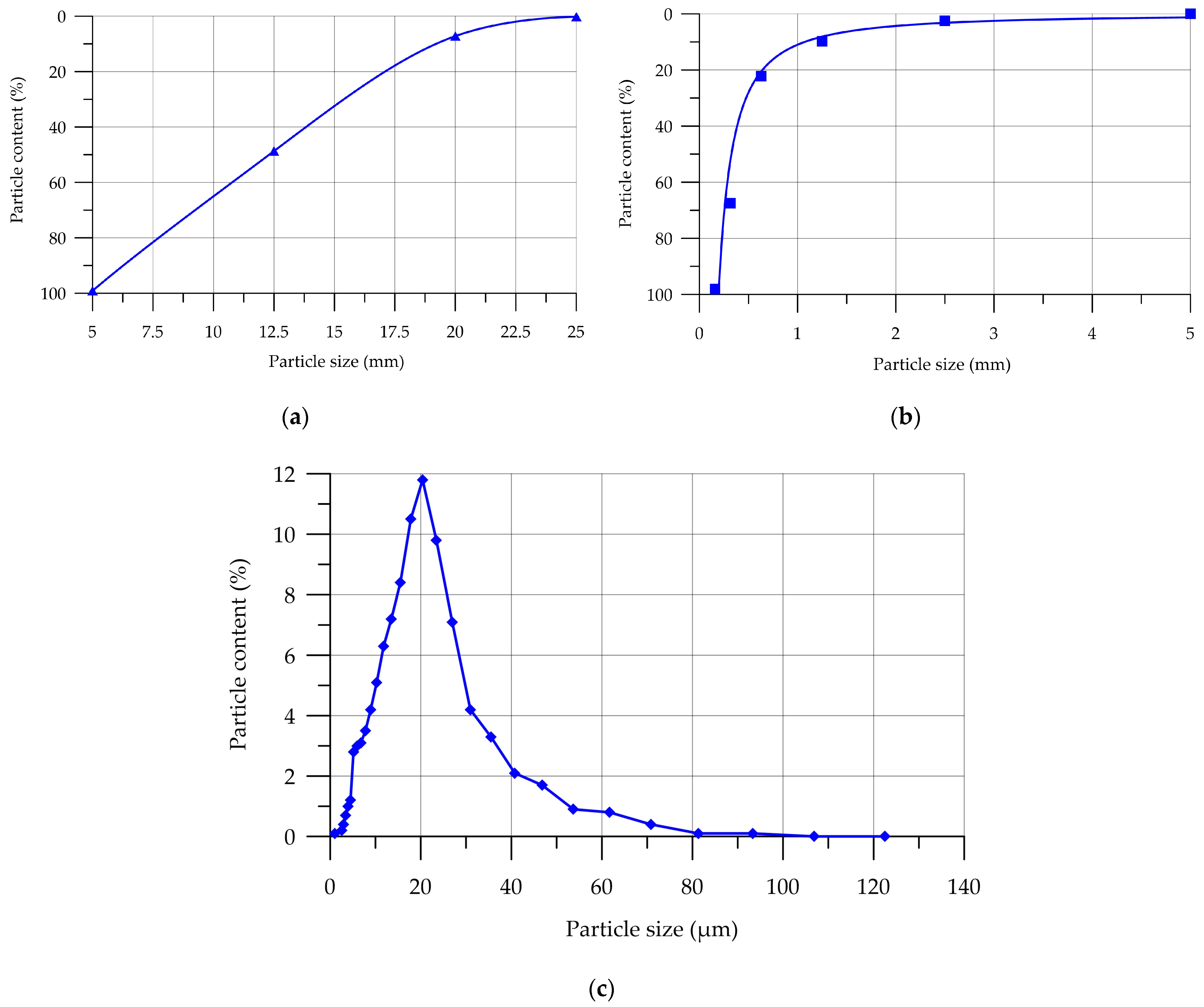

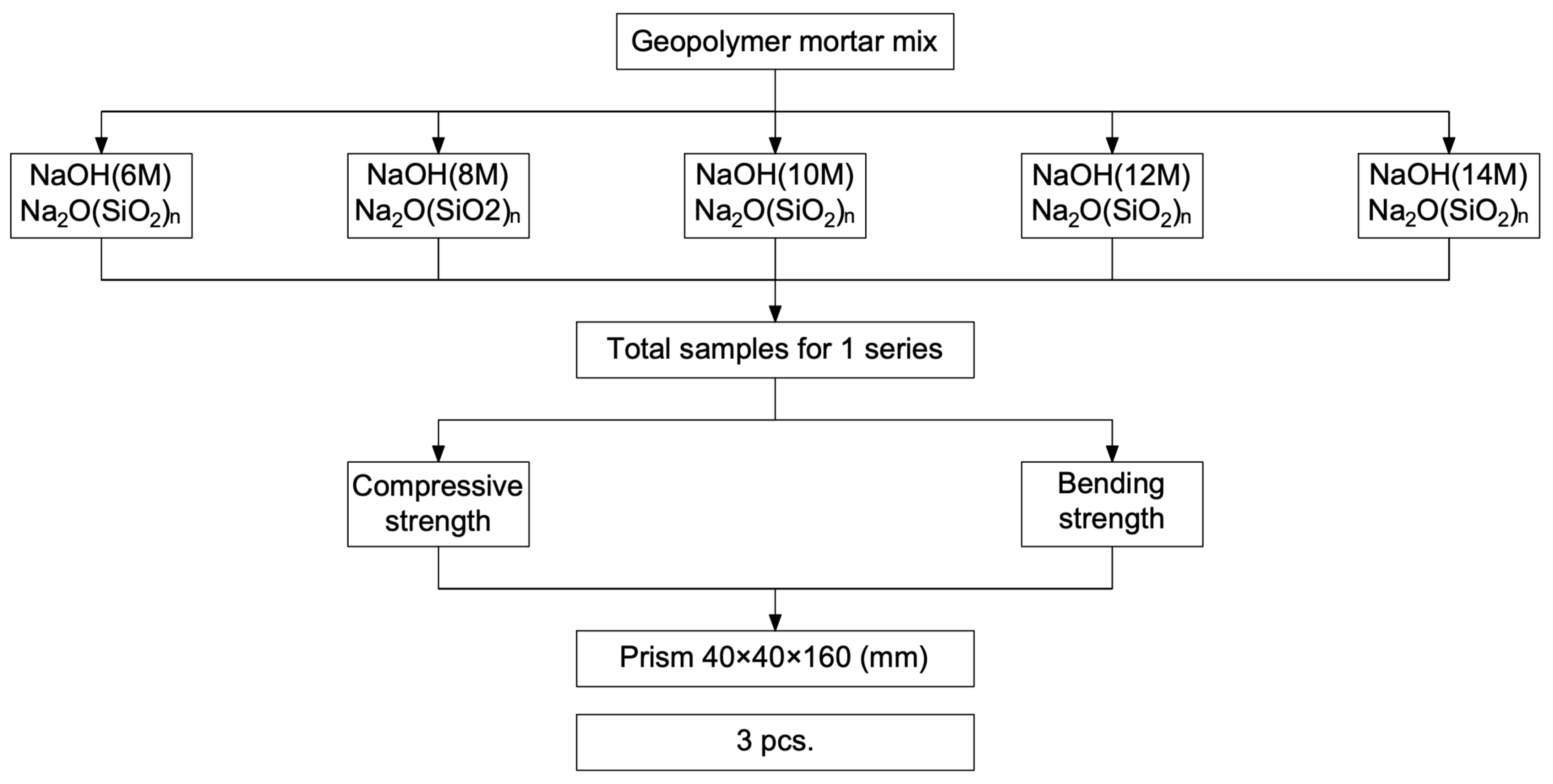
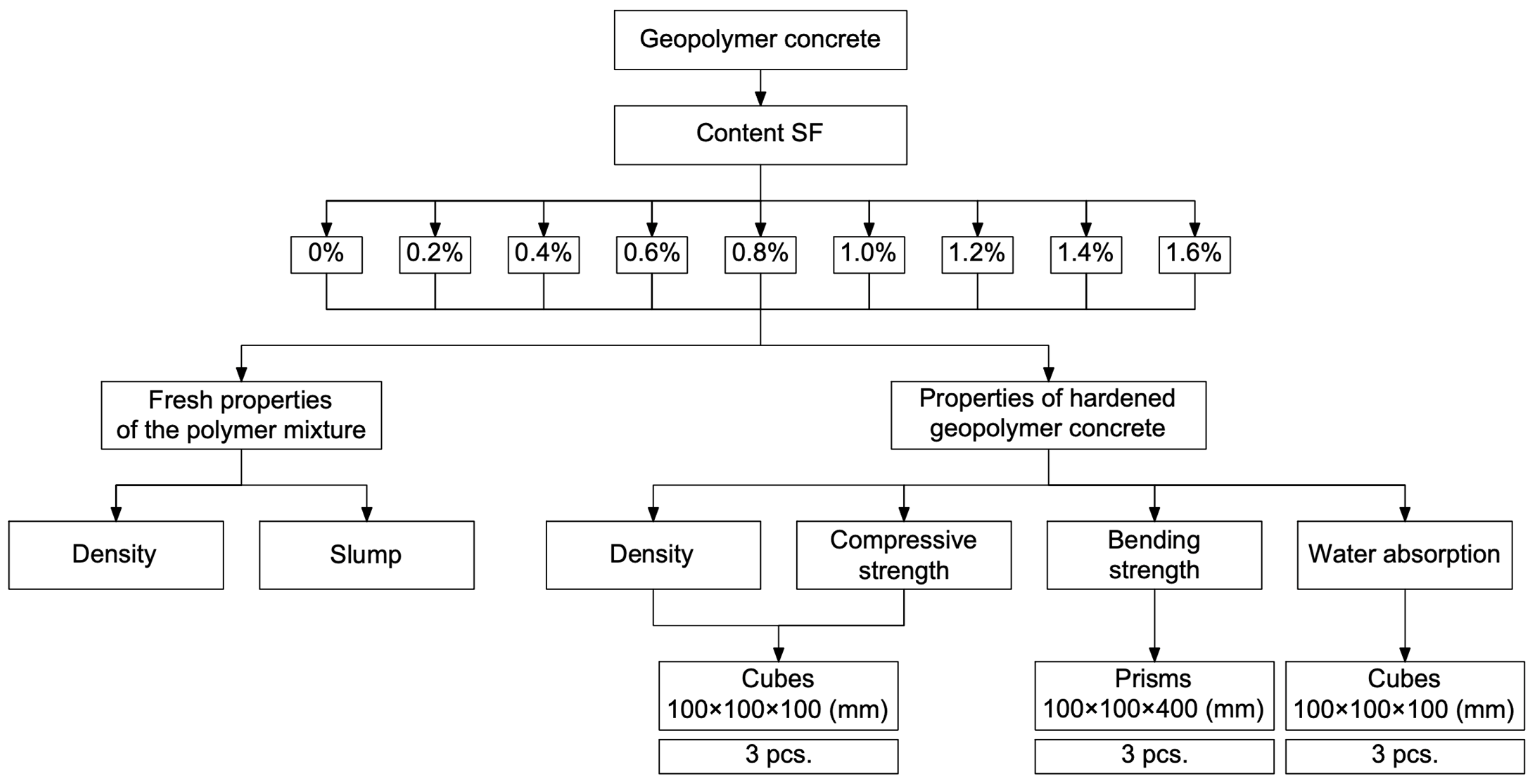

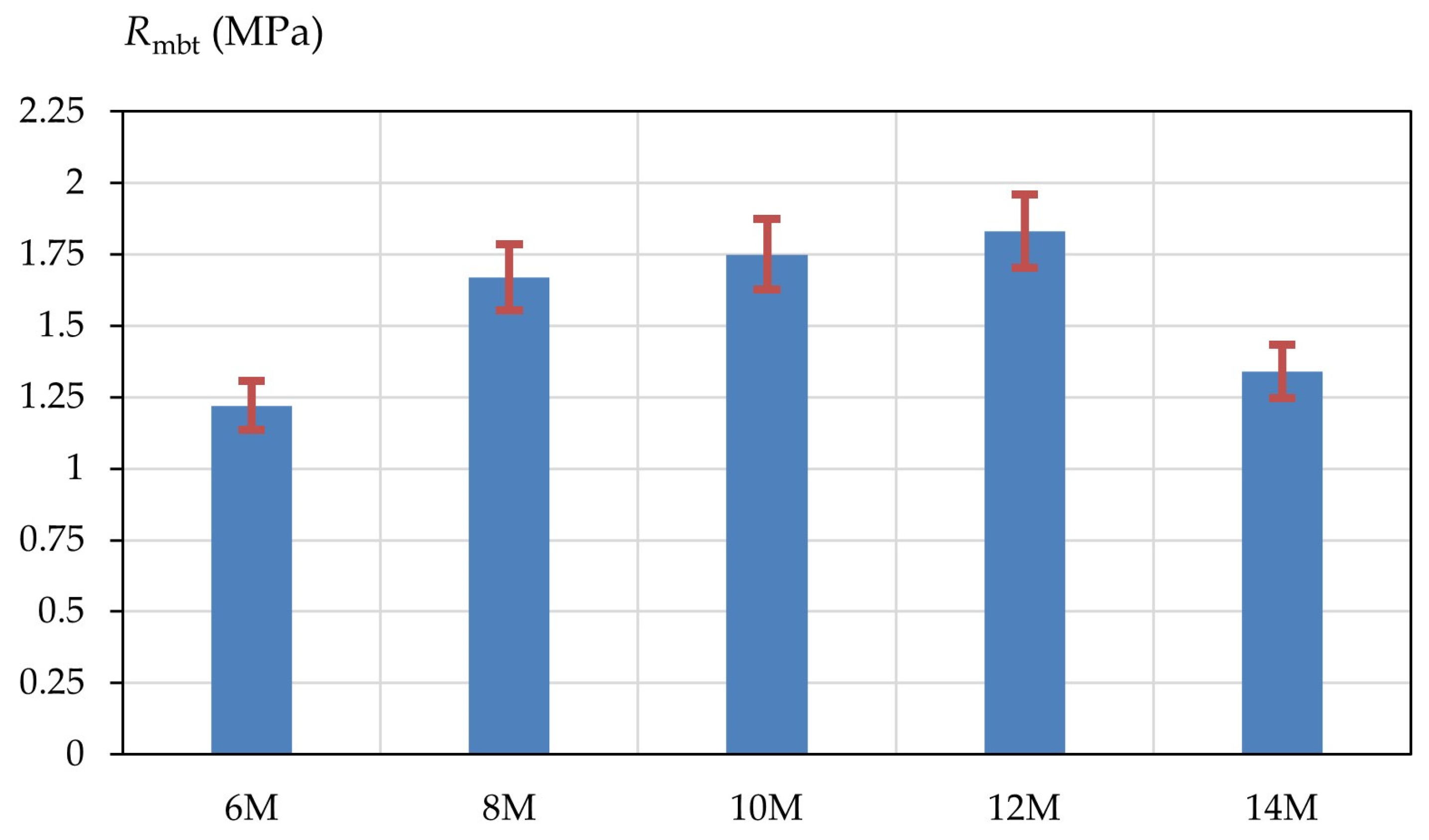
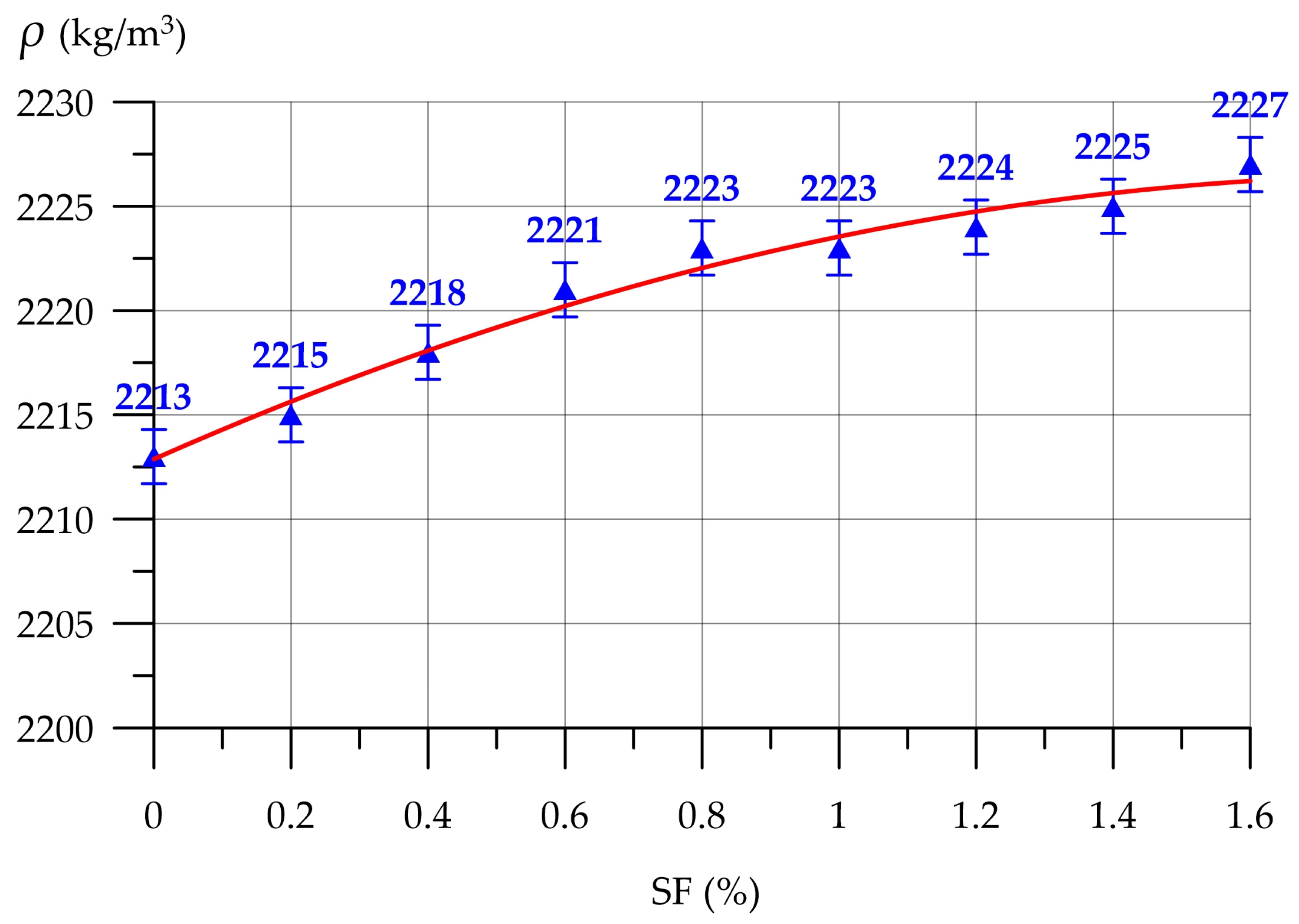
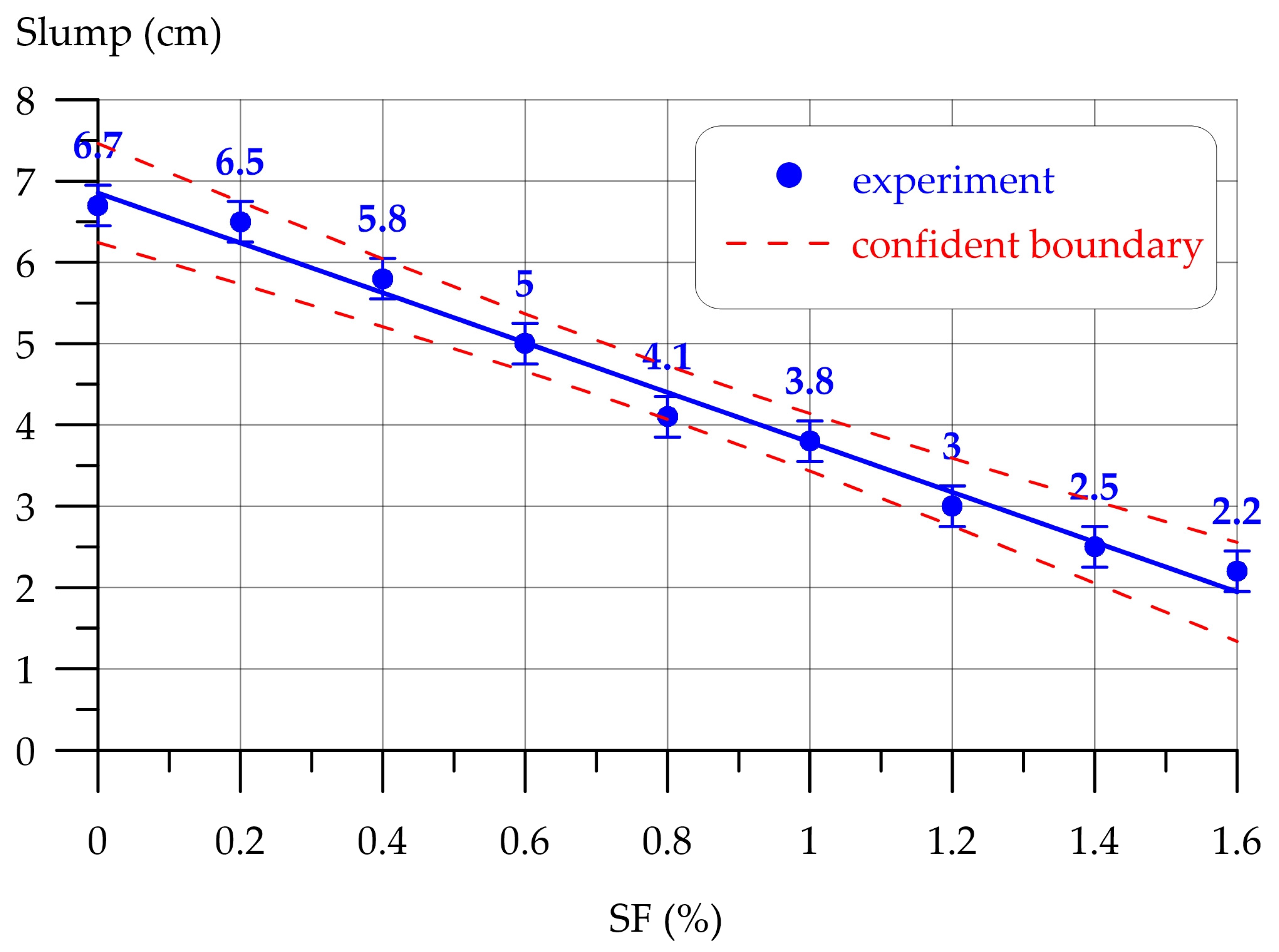
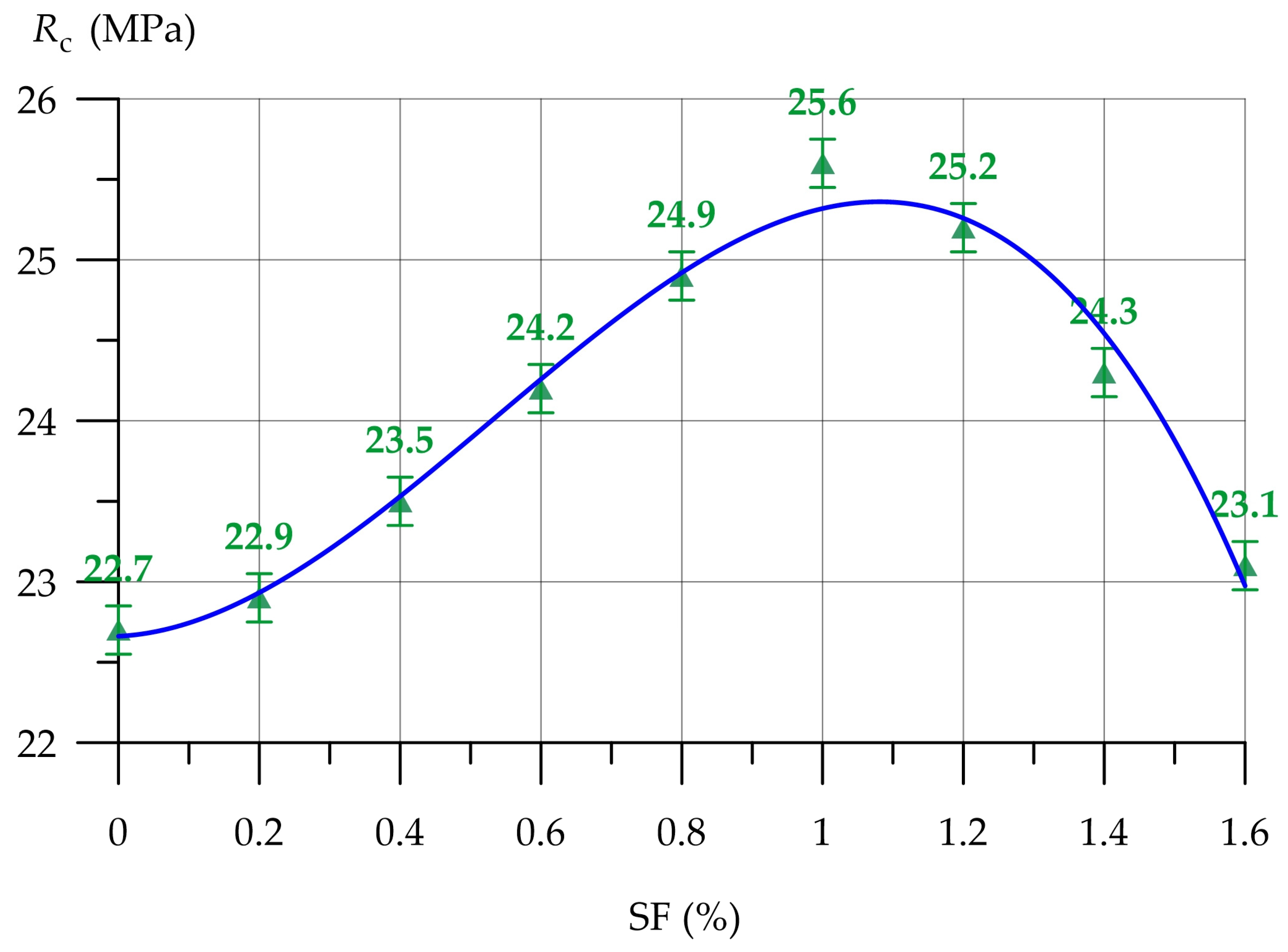
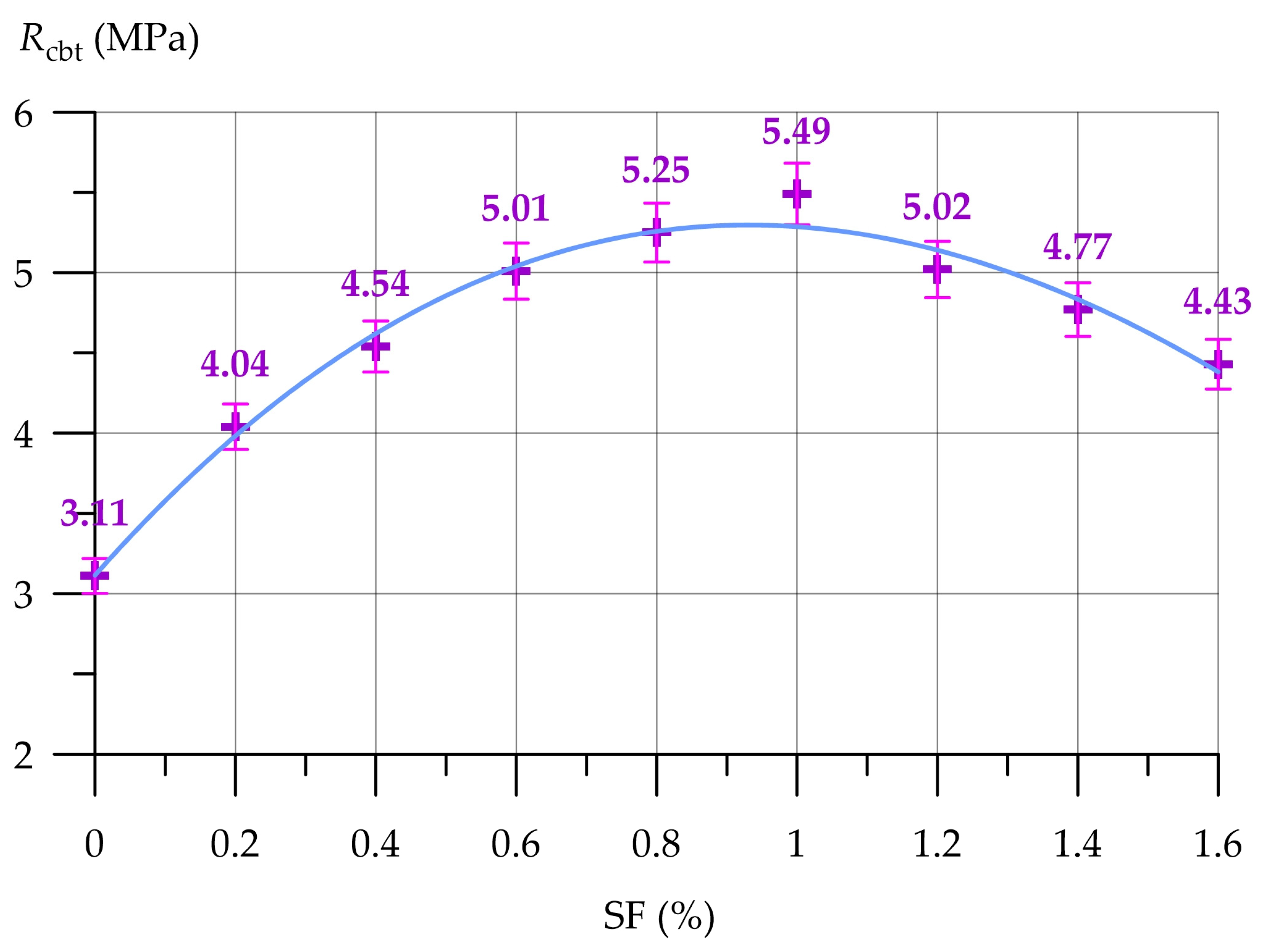

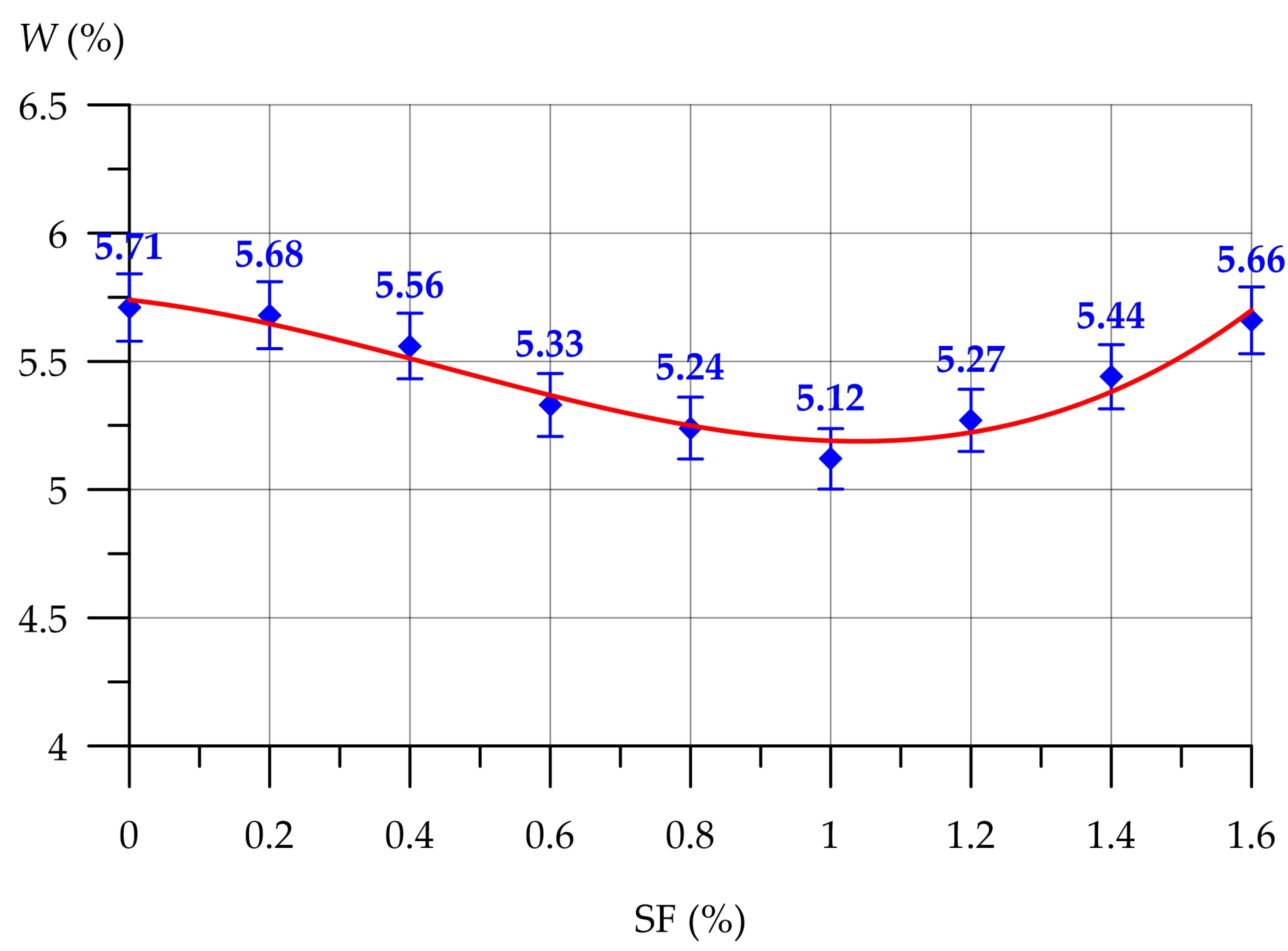
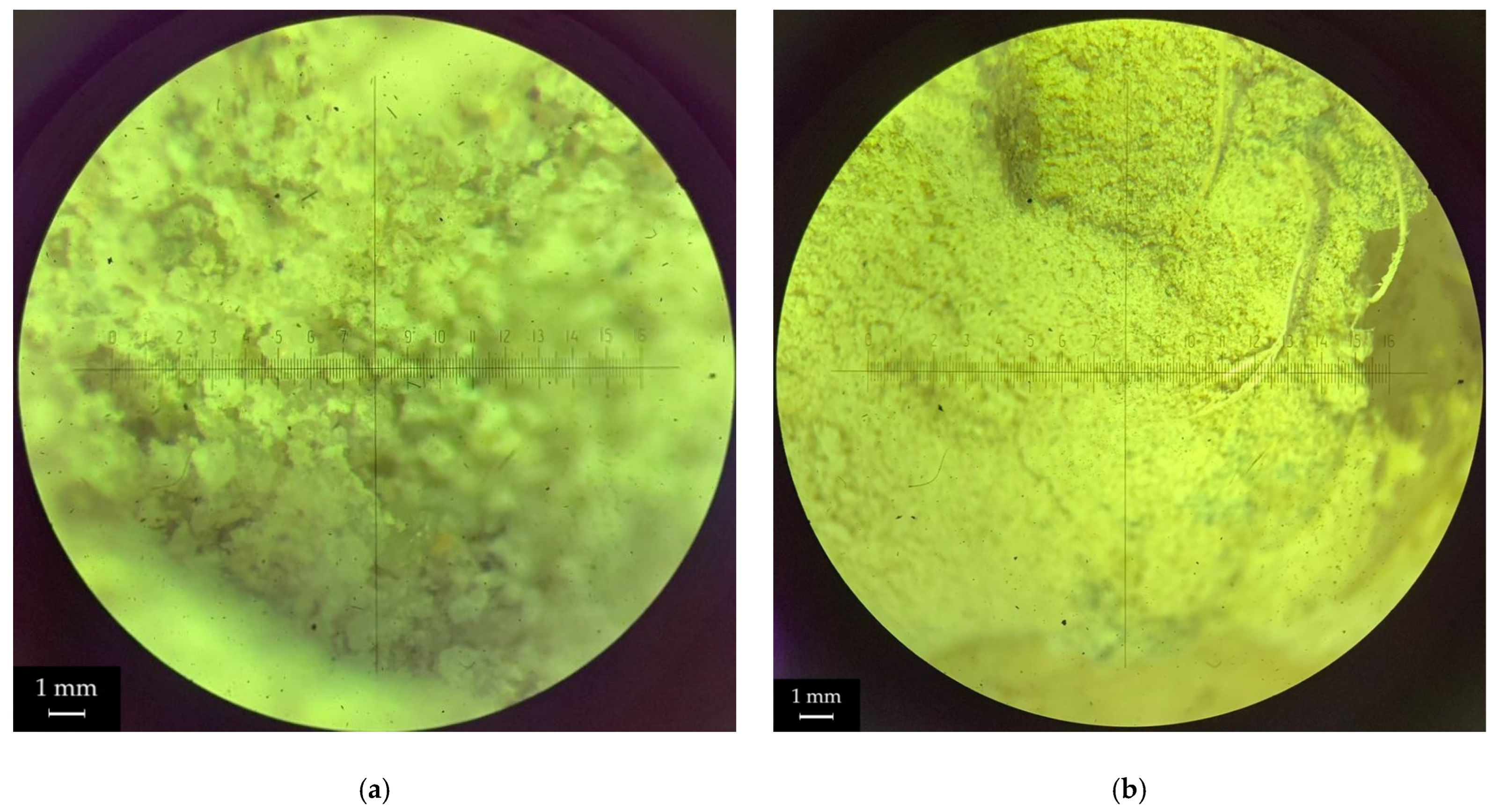
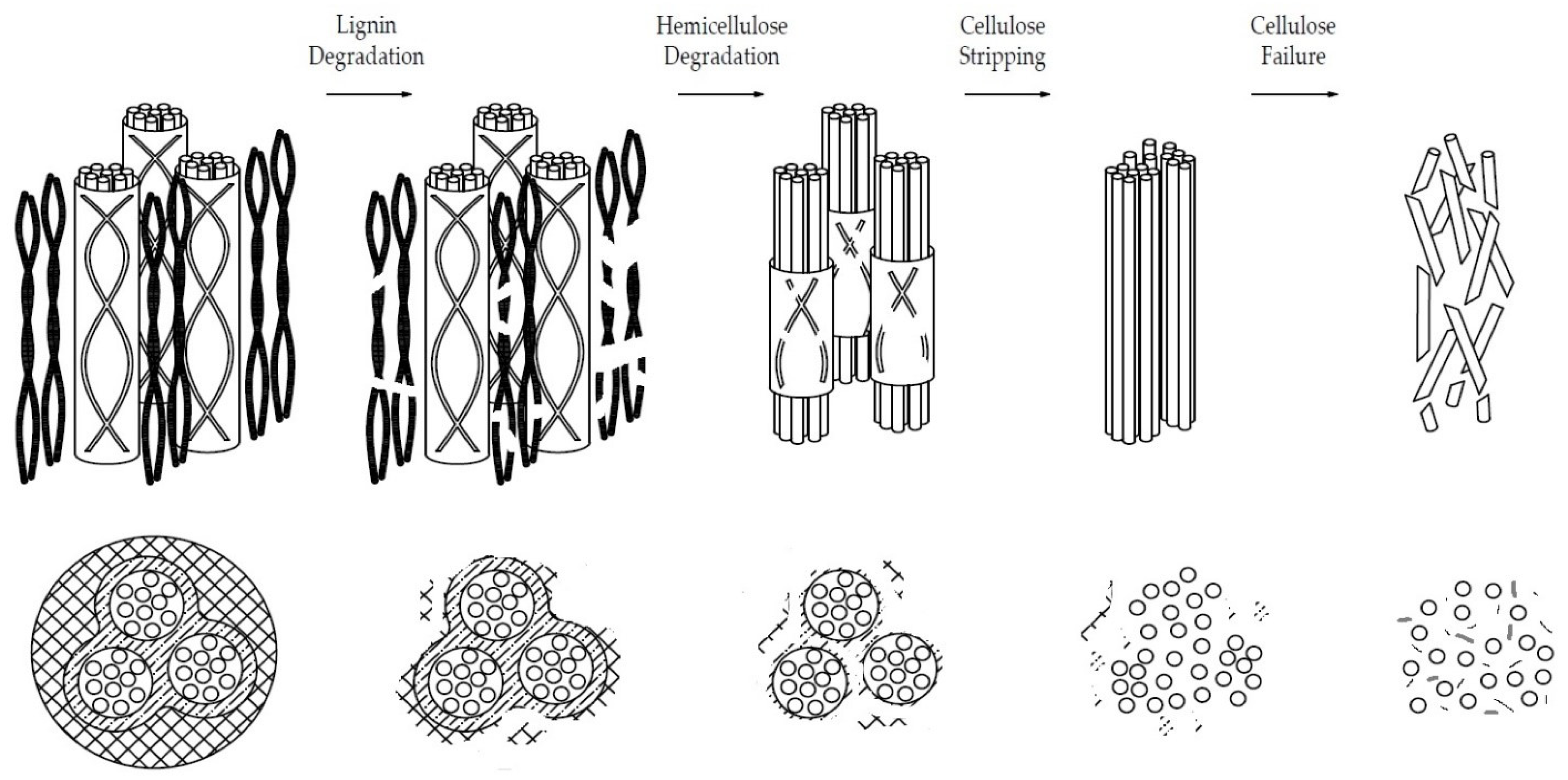
| GGBS | LOI (%) | SiO2 (%) | Al2O3 (%) | Fe2O3 (%) | CaO (%) | MgO (%) | TiO2 (%) | P2O5 (%) | SO3 (%) |
| 11.38 | 32.15 | 5.92 | 0.73 | 40.56 | 5.83 | 0.28 | 0.04 | 3.11 |
| QS | Bulk Density (kg/m3) | Apparent Density (kg/m3) | Content of Dust and Clay Particles (%) | Content of Clay in Lumps (%) | Organic and Contaminant Content (%) |
| 1378 | 2593 | 0.02 | 0.05 | No |
| CSS | Bulk Density (kg/m3) | Apparent Density (kg/m3) | Resistance to Fragmentation (wt%) | Content of Lamellar and Acicular Grains (wt%) |
| 1427 | 2661 | 11.2 | 5.6 |
| SF | Fiber Density (g/cm3) | Porosity (%) | Tensile Strength (MPa) | Tensile Ultimate Strain (%) | Elasticity Modulus (GPa) |
| 1.5 | 12–14 | 381 ± 23.6 | 2.45 ± 0.1 | 28.5 ± 8 |
| Indicator | Actual Value |
|---|---|
| Solvent | white spirit |
| Proportion of nonvolatile substances (dry residue) (wt.%) | 48–52 |
| Conditional viscosity at temperature (20 ± 0.5) °C according to the VZ-246 viscometer (s) | 80–150 (Ø4) |
| MK-85 | SiO2 (%) | CaO (%) | Al2O3 (%) | Fe2O3 (%) | MgO (%) | Na2O (%) | K2O (%) | C (%) | S (%) | Bulk Density, (kg/m3) |
| 95.7 | 0.93 | 0.67 | 0.69 | 0.45 | 0.64 | 0.09 | 0.4 | 0.43 | 158.7 |
| Mixture Type | GGBS (g) | QS (g) | NaOH (g)/ Molarity of Solution | Na2O(SiO2)n (g) | Water (g) |
|---|---|---|---|---|---|
| 6M | 500 | 1500 | 56 (6M) | 124 | 70 |
| 8M | 500 | 1500 | 56 (8M) | 124 | 70 |
| 10M | 500 | 1500 | 56 (10M) | 124 | 70 |
| 12M | 500 | 1500 | 56 (12M) | 124 | 70 |
| 14M | 500 | 1500 | 56 (14M) | 124 | 70 |
| Mixture Type | GGBS (kg/m3) | QS (kg/m3) | CSS (kg/m3) | NaOH (kg/m)3 | Na2O(SiO2)n (kg/m3) | SF (kg/m3) | Indpol 027 (kg/m3) | MK-85 (kg/m3) | Water (L/m3) |
|---|---|---|---|---|---|---|---|---|---|
| 12M/SF0 | 390 | 567 | 1012 | 48 | 105 | 0.00 | 19.5 | 11.7 | 60 |
| 12M/SF0.2 | 390 | 567 | 1012 | 48 | 105 | 0.78 | 19.5 | 11.7 | 60 |
| 12M/SF0.4 | 390 | 567 | 1012 | 48 | 105 | 1.56 | 19.5 | 11.7 | 60 |
| 12M/SF0.6 | 390 | 567 | 1012 | 48 | 105 | 2.34 | 19.5 | 11.7 | 60 |
| 12M/SF0.8 | 390 | 567 | 1012 | 48 | 105 | 3.12 | 19.5 | 11.7 | 60 |
| 12M/SF1.0 | 390 | 567 | 1012 | 48 | 105 | 3.90 | 19.5 | 11.7 | 60 |
| 12M/SF1.2 | 390 | 567 | 1012 | 48 | 105 | 4.68 | 19.5 | 11.7 | 60 |
| 12M/SF1.4 | 390 | 567 | 1012 | 48 | 105 | 5.46 | 19.5 | 11.7 | 60 |
| 12M/SF1.6 | 390 | 567 | 1012 | 48 | 105 | 6.24 | 19.5 | 11.7 | 60 |
| Reference Number | Fiber Name | Best Dosage | Result |
|---|---|---|---|
| [72] | Flax fibers | 1% | Flexural strength increased by 22% |
| [73,74] | Cotton fibers | 0.5% | Higher values of flexural strength and fracture toughness were obtained |
| [75] | Miscanthus fiber | 0.2%–0.4% | The compressive strength of geopolymer foam concrete increased from 0.007 MPa to 0.719 MPa |
| [76] | Sisal fibers/jute fibers | 2.5%/1.5% | The compressive, splitting, and flexural strengths increased by 76%, 112%, and 270% with the addition of sisal fibers. With the addition of jute fibers, these types of strength increased by 64%, 45%, and 222%, respectively. |
| [77] | Sisal fibers | 2.0% | The use of sisal fibers treated with a 10% NaHCO3 solution provided an increase in bending strength of 53% and impact strength of 82% |
| [78] | Abaca fiber | 1.0% | The compressive and flexural strength increased by 20% and 161%, respectively |
| [79,80] | Sisal fibers | 1.0% | The mechanical properties of the geopolymer concrete improved |
Disclaimer/Publisher’s Note: The statements, opinions and data contained in all publications are solely those of the individual author(s) and contributor(s) and not of MDPI and/or the editor(s). MDPI and/or the editor(s) disclaim responsibility for any injury to people or property resulting from any ideas, methods, instructions or products referred to in the content. |
© 2024 by the authors. Licensee MDPI, Basel, Switzerland. This article is an open access article distributed under the terms and conditions of the Creative Commons Attribution (CC BY) license (https://creativecommons.org/licenses/by/4.0/).
Share and Cite
Shcherban’, E.M.; Stel’makh, S.A.; Beskopylny, A.N.; Meskhi, B.; Efremenko, I.; Shilov, A.A.; Vialikov, I.; Ananova, O.; Chernil’nik, A.; Elshaeva, D. Composition, Structure and Properties of Geopolymer Concrete Dispersedly Reinforced with Sisal Fiber. Buildings 2024, 14, 2810. https://doi.org/10.3390/buildings14092810
Shcherban’ EM, Stel’makh SA, Beskopylny AN, Meskhi B, Efremenko I, Shilov AA, Vialikov I, Ananova O, Chernil’nik A, Elshaeva D. Composition, Structure and Properties of Geopolymer Concrete Dispersedly Reinforced with Sisal Fiber. Buildings. 2024; 14(9):2810. https://doi.org/10.3390/buildings14092810
Chicago/Turabian StyleShcherban’, Evgenii M., Sergey A. Stel’makh, Alexey N. Beskopylny, Besarion Meskhi, Innessa Efremenko, Alexandr A. Shilov, Ivan Vialikov, Oxana Ananova, Andrei Chernil’nik, and Diana Elshaeva. 2024. "Composition, Structure and Properties of Geopolymer Concrete Dispersedly Reinforced with Sisal Fiber" Buildings 14, no. 9: 2810. https://doi.org/10.3390/buildings14092810












